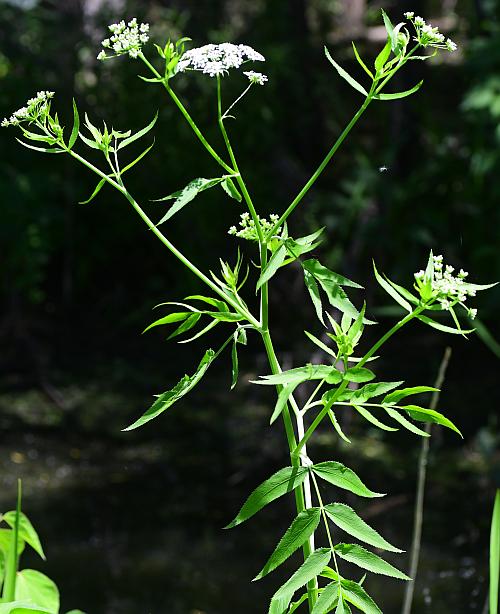Sium suave Walter
Water Parsley

Native
CC = 6
CW = -5
MOC = 30
© SRTurner
Sium suave WalterWater Parsley | |
 |
Native CC = 6 CW = -5 MOC = 30 |
© SRTurner |
|
Family - Apiaceae Habit - Fibrous-rooted perennial forb, glabrous. Often emergent aquatic. Stem - Ascending to erect, to 2 m, often ridged relatively stout, glabrous.
Leaves - Alternate and sometimes basal, dimorphic, petiolate or upper leaves sessile, sheathing bases not or slightly inflated. Submerged leaf blades multiply pinnately or dichotomously dissected. Leaf blades 2-30 cm long, narrowly oblong to broadly ovate in outline, 1 time pinnately compound with 7-17 leaflets, those of the uppermost leaves sometimes simple, the leaflets 10-100 mm long, lanceolate to narrowly ovate, narrowed or rounded at the base, sharply and often finely many-toothed along the margins, narrowed or tapered to a sharp point at the tip, those of submerged leaves usually deeply and finely dissected into linear segments.
Inflorescences - Inflorescences terminal and axillary, compound umbels, short- to long-stalked. Involucre of 6-10 bracts, these 3-15 mm long, linear to lanceolate, the broader ones usually with irregular, white, papery margins. Rays 10-20, 1.0-4.5 cm long. Involucel of 4-8 bractlets, these mostly shorter than the flower stalks, entire, linear to narrowly lanceolate, sometimes with narrow, white margins.
Flowers - Mostly numerous in each umbellet, the stalks 3-5 mm long. Sepals absent or minute triangular scales. Petals elliptic-obovate, shallowly notched or narrowed or tapered abruptly to a short, slender tip, white. Ovaries glabrous.
Fruits - Schizocarps 2-3 mm long, broadly elliptic to nearly circular in outline, slightly flattened laterally, glabrous, tan to straw-colored, with prominent reddish brown oil tubes filling the spaces between the ribs, the mericarps slightly narrowed along the commissures, with 5 prominent ribs, these with short, thick, corky wings.
Flowering - July - September. Habitat - Marshes, swamps, bottomland prairies, pond margins, ditches. Origin - Native to the U.S. Lookalikes - Oxypolis rigidior, more broadly, many other members of the Apiaceae, including species of Angelica, Levisticum, Ligusticum, Cicuta, Perideridia, and others. Other info. - This characteristic species of good-quality wetlands is found in scattered locations in Missouri, predominantly in the eastern half of the state. Its broader range includes much of the northern half of the continental U.S., and also Canada and Alaska. Photographs taken at Shaw Nature Reserve, Franklin County, MO, 7-30-2007, and at Marais Temps Clair Conservation Area, St. Charles County, MO, 8-2-2018 and 7-28-2020 (SRTurner). |